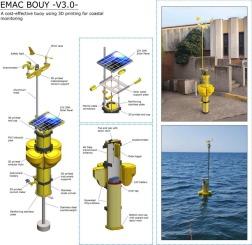Design and development of a cost-effective buoy using 3D printing for coastal monitoring
IF 2.1
Q3 ENGINEERING, ELECTRICAL & ELECTRONIC
引用次数: 0
Abstract
An adequate knowledge of water (and air) environment parameters in ocean and coastal areas becomes of crucial importance for management practices. The behavior of oceans and coasts covers a large range of spatial and time scales that leads to the importance of high-frequency and widespread monitoring by using cost-effective platforms. This article proposes the design, development and deployment of a low-cost, small and compact buoy platform for coastal monitoring, which was built almost entirely on 3D printing technology in a modular way. The buoy called EMAC buoy -V3.0- (EMAC: Estación de Monitoreo Ambiental Costero) was significantly improved in the last few years based on cost-effective optimization and physical constraints inherent to coastal waters, providing the advantages of simplicity and flexibility. This study considered oceanographic and meteorological measurements of a buoy moored in the San Matías Gulf on the northern Patagonian Continental Shelf.

使用3D打印设计和开发具有成本效益的浮标,用于海岸监测
充分了解海洋和沿海地区的水(和空气)环境参数对管理实践至关重要。海洋和海岸的行为涵盖了大范围的空间和时间尺度,因此必须使用具有成本效益的平台进行高频和广泛的监测。本文提出了一种低成本、小型、紧凑型的海岸监测浮标平台的设计、开发和部署,该平台几乎完全采用3D打印技术模块化构建。该浮标名为EMAC浮标- v3.0 - (EMAC: Estación de Monitoreo Ambiental Costero),在过去几年中,基于成本效益优化和沿海水域固有的物理限制,该浮标得到了显著改进,具有简单灵活的优点。这项研究考虑了在巴塔哥尼亚北部大陆架圣Matías湾停泊的浮标的海洋学和气象测量。
本文章由计算机程序翻译,如有差异,请以英文原文为准。
求助全文
约1分钟内获得全文
求助全文
来源期刊

HardwareX
Engineering-Industrial and Manufacturing Engineering
CiteScore
4.10
自引率
18.20%
发文量
124
审稿时长
24 weeks
期刊介绍:
HardwareX is an open access journal established to promote free and open source designing, building and customizing of scientific infrastructure (hardware). HardwareX aims to recognize researchers for the time and effort in developing scientific infrastructure while providing end-users with sufficient information to replicate and validate the advances presented. HardwareX is open to input from all scientific, technological and medical disciplines. Scientific infrastructure will be interpreted in the broadest sense. Including hardware modifications to existing infrastructure, sensors and tools that perform measurements and other functions outside of the traditional lab setting (such as wearables, air/water quality sensors, and low cost alternatives to existing tools), and the creation of wholly new tools for either standard or novel laboratory tasks. Authors are encouraged to submit hardware developments that address all aspects of science, not only the final measurement, for example, enhancements in sample preparation and handling, user safety, and quality control. The use of distributed digital manufacturing strategies (e.g. 3-D printing) is encouraged. All designs must be submitted under an open hardware license.
 求助内容:
求助内容: 应助结果提醒方式:
应助结果提醒方式:


